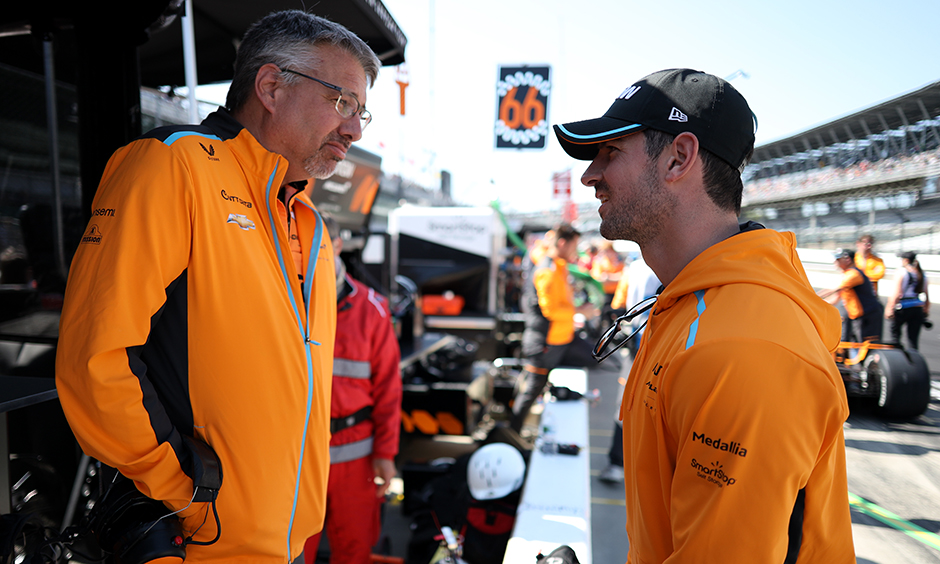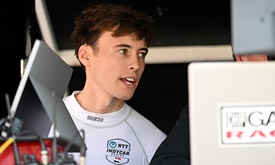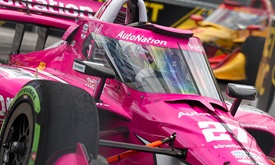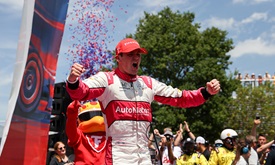The Setup: Indianapolis Road Course with Craig Hampson
AUG 08, 2023
Note: This is a continuing series for INDYCAR.com, with different guests, leading into each race weekend for the NTT INDYCAR SERIES, focusing on various technical challenges of each respective circuit.
The 14th round of the 2023 season for the NTT INDYCAR SERIES returns home for a unique Brickyard Weekend with NASCAR and the Gallagher Grand Prix on the Indianapolis Motor Speedway road course.
The 2.439-mile, 14-turn (five left, nine right) road course includes a section of the superspeedway oval, with competitors going clockwise down 2,869 feet of the front straight before hitting the rest of the interior circuit. The track remains relatively flat throughout, with up to 9 degrees of banking making up a small portion of the layout.
A two-day event for North America’s premier open-wheel championship features begins with a 90-minute opening practice at 9 a.m. ET Friday, along with an NTT P1 Award qualifying bout at 12:30 p.m. that is followed by a 30-minute final practice at 4 p.m. On Saturday, the field is set for an 85-lap (207.315 miles) race set to have the green flag wave at 2 p.m. ET (USA, Peacock, INDYCAR Radio Network). The qualifying record is held by Will Power, who stormed to a flying lap of 1 minute, 7.7044 seconds (129.687 mph) in 2017.
This week’s featured guest is Craig Hampson, race engineer for Alexander Rossi’s No. 7 Arrow McLaren Chevrolet. Hampson helped guide Rossi to a third-place result on the IMS road course in May for his first podium finish with his new team. Rossi’s most recent NTT INDYCAR SERIES victory came in this event last year while driving for Andretti Autosport.
Q: What is it like preparing for the Brickyard weekend at the IMS road course?
Craig Hampson: Well, a couple of things. It’s more compressed. You don’t have much practice time, usually. There's only one practice before qualifying, which is less than normal. But I think they work on the assumption that you've already been here previously in the year. So, while it's a longer than normal practice, it is less time, and you don't then have that in between practices thing to make a major change like put in a different differential or change a suspension geometry. If you want to do that, you're just carrying it right into qualifying and you better hope that you're correct, as opposed to an opportunity to check it in a subsequent practice. That's one thing. The other thing is typically it is much hotter in August than it is in early May. These cars are obviously very sensitive to temperature of the track surface and then also the air temperature. The air temperature changes the density of the air, which changes the downforce level that the car has. Then the track surface, there's an interaction between the rubber molecules of the tire and the pavement surface, and that interaction changes depending upon how hot everything is. Those are big deals, so just because you were good in May does not necessarily mean you'll be good in August. Obviously, the opposite can be true because conditions can really dictate a lot. The other thing is, according to the document Firestone has given us, the alternate (red sidewall) tires are different than they were in May. Now, we've used them before in the past, but when you switch tire compounds, which alternates and primes (black sidewall) are always the same construction, it's just a different rubber compound, it definitely changes the grip level of the car. When you change the grip level of the car, it changes the balance of the car. So, the offset between running around on primes in practice and then how do you adjust it to get on the alternates, that's going to be a different offset in May versus now. We have to try to take all of that into account, and we have to figure it all out in one practice. Indianapolis is one of the smoothest tracks we go to, which is nice. Dampers are usually extremely important in this series - your sort of ride; your grip - but I would venture it's maybe a little less important at this track than somewhere like Nashville or Toronto, where it's really bumpy. Still, it is important that your dampers be able to take curbs in some places at the Indianapolis road course because there are several curbs that you want to be able to touch or ride over. Also, Indianapolis has a few areas which you definitely compromise corners to set up other corners, and how the driver approaches that and how your car handles that could be pretty critical. In particular, the (Turns) 7, 8, 9, 10 area, our team calls it "The Snake." I've been places that call it "The Esses," but it's a sequence of four apexes and if you really whistle your car through one of those apexes, on the next one you're not going to be in the right place, and you'll be slow in the subsequent one. So, making the correct compromises in terms of where you place the car, but also the car's balance behavior, is pretty critical for that section. The track is sensitive to wind direction, for sure. So, it can behave like a very different circuit. If the wind is say, blowing from the north instead of blowing from the south, if it's a crosswind in both directions or a crosswind to those, it can affect the esses in a good or a bad way.
Q: What about the track?
Hampson: Turn 14 is your limit to a lot of things. It is for the race, certainly far and away the most important corner because it leads onto the longest straightaway and it leads onto the best passing zone. If you are very weak through there, you're going to get picked off in the race and if you're very strong in there, you will be able to pass people. The problem is the car is going fast enough and is heavily enough loaded in that corner that it can be neutral, it can be loose, so you work fairly hard to secure it through there so you can keep your foot down on the throttle or at least not lift very much. But in doing so, that compromises a lot of the rest of the track. You go, "OK, well I've made the rear good enough in that corner, and now it just understeers everywhere." That is one of the big arts to the Indianapolis road course, is figuring out how to get at least the right compromise between those for qualifying and for racing. Turn 1, braking is super important because it is a passing zone. There's a lot of time to be made on the brakes there. The whole track really is sensitive to how the driver dances on the pedals. I would say the casual fan probably doesn't realize that a lot of the art of driving a race car, particularly an INDYCAR, is actually what you do with your feet, not just what you're doing with your hands because you could really change the way the car behaves or the balance of the car through a corner depending upon what you do with the brake: how long you carry the brake, how hard you hit the brake, and then what you do with the throttle on the way out. The cars are always on the edge of grip no matter what you're doing because that's the only way to be fast. You're trying to spin this plate on the edge of your finger and it's always trying to go this way or that, and you're able to manipulate the balance of that using your feet. Take Turn 1 for example, you can brake really hard, and you can lock the rears on the way in and that upsets the car on the way in, but if you carry that brake too far and too heavy, you start locking the front tires, particularly the inside front. And when you lock any tire, that tire no longer has any grip to help you go around a corner. When you lock the rears, the car wants to spin and when you lock the inside front, it doesn't want to turn. Suddenly you find yourself going through the escape road between (Turns) 1 and 3, so there's a real compromise there on braking at Turn 1. There are a few other places where you have to balance entry in mid-corner. You're always fighting the same thing: The rear is not good enough on entry, the front is not good enough mid-corner, and then the rear is not good enough on traction or on exit. And it's always how can we even those things out and address the things that are making us slow? You're never going to solve that. Like every Indy car has that stuff, but you can adjust the compromise, the weighting of the compromise, and its behavior for certain corners. Turn 4, leading onto the back section, the entry can be bad. It can particularly be bad if the wind is not favorable to you, but then it'll settle into an understeer, and then you have an understeer. Turn 5, the rear can definitely be on the limit, and that's worse depending upon the wind direction. You have to make sure you’re able to ride over the curb at Turn 6. Other places where the rear can be bad on the way in are Turn 13, and then it can have a big understeer in the middle. Sometimes if you have a really bad entry, it also results in an understeer in the middle because when your entry is bad, you've just ended up in the wrong place on the track. You didn't take the corner how you want it. So, now you've got the worst of both worlds. You have a bad entry, and you have understeer because you're not driving the car, the car is driving you.
Q: How tricky is it to navigate grip since this weekend not only are the conditions typically warmer, but you also have the different tire rubber to deal with from the NASCAR cars?
Hampson: Historically, the other manufacturer's tires and the Firestone rubber are not particularly friendly with each other, which is very bizarre seeing as they both come out of Akron, Ohio. Historically, and particularly on the ovals, they don't like each other as much. Thankfully for us, we do the majority of our running before they do, and they tend not to get much practice anymore within that series. That's become less of an issue for us then. If you told me they were going to have a race and then we were going to have a race, I would be really worried about it because their rubber would be spread all over the track. But thankfully both the Xfinity race and the Cup race happens after us. So, I think they're probably more worried about it than we are.
Q: From a general setup point of view, is there anything different in terms of ride heights, dampers, suspension softness or stiffness, gearing, etc.?
Hampson: With the temperature, the grip level can vary quite a bit. So, it is not necessarily like a May setup or an August setup. It is more like a 70-degree setup and a 90-degree setup. And that applies to a lot of circuits, but for us this is particularly relevant because we go here twice. It tends to be when it gets hot you lose grip and when you lose grip, you lose grip on the end of the car that was inherently weaker. Depending upon your setup, if you had more understeer, you would have even worse understeer, if you lacked rear security, you will have an even bigger problem than that. So, you need to definitely be thinking about what was the worst axle of the car at the previous time we were there if it's going to get hotter. The other thing is when it's cool at this circuit, you do have the ability to trim downforce a little, but it has tended to be that you really can't do that in August due to the hotter temperatures. The fact that that compromises the grip level, do we have a dramatically different baseline setup between May and August? No. But do we have offsets of things, and I'm generically speaking here of course, but things like a weight distribution or a suspension geometry or what coil springs we have put on the car being different? Yes.
Q: You mentioned Turn 14 earlier; would you gauge that as the trickiest corner of the IMS road course?
Hampson: Yeah, for sure. Obviously, there's a lot of time to be gained or lost down the straightaway, but it is much more important for the race than it is for qualifying. So, you might choose to make different setup decisions for each of those sessions depending upon what your car is doing. Because if you are, say, using up the rear tires very quickly, you might be able to get through (Turn) 14 fine for one lap or maybe two, but you're not going to make it through a stint. And then if the rear tires are going off very badly and you are lifting a lot through (Turn) 14 because the driver is scared and saving his life, people are going to pick them off. Again, the compromise you make for like the mid-corner understeer versus taking care of the rear tires and getting through (Turn) 14 would be pretty different between the two sessions.
Q: What is the challenge of keeping the car balance over the length of a stint during Brickyard Weekend with the typically warmer temperatures?
Hampson: I'm not sure you really can keep the balance consistent, but what you need to do is make sure that you aren't going to wear out one axle end of the tires more quickly than the other. We might refer to that as falling apart or falling off the cliff. You know, you'll see somebody running fine for 15 laps, and then suddenly they look like they're drowning. What you want to do is do your best to avoid that drowning episode because you tend to lose a lot of positions or get in a strategic hole if you have to compromise your pit sequence like that. A lot of the time, for example, if you're having some traction issues or entry issues, you might have to protect the rear tires and then you would make compromises to the setup. That ultimately means your car will be slower for one lap, but over the length of a full fuel stint or the full use of the tires, you will be quicker because you didn't destroy one axle end of the car. The best-balanced cars, like they always wear the tires out, you can't not wear the tires out our car weighs a lot, it's going around the corners really, really fast, putting a huge amount of energy into those tires. Ideally, you want to wear them out equally, so the balance doesn't go one way or the other. But the tough thing in that is that the alternates and the primes have different levels of grip. They're made from different rubber. So, if you're really nicely balanced on one, it is not going to be really nicely balanced on the other. So, you have to try and make adjustments for that. Sometimes it's as simple as you're going to adjust front wing or maybe you'll run some different tire pressures or something. But this weekend, if they truly are different alternates, whatever we did in May or we did last year with that same offset does not work. Every weekend we run a set of alternate tires in first practice, and that is really your only opportunity to know what offset that needs to be and when we put the alternate tires on, how does it change the car's behavior?
Q: What have you learned in working with Alexander this year?
Hampson: This is the first year with Alex. This will be the first track we go to that we have been at before, which is a positive. This is our second bite at the apple, and we've been learning on the job here because we get very little track testing now in INDYCAR. Honestly, we get very little track time during the weekend. This year has been a struggle for us with the No. 7 car, not particularly in the races because, as an example, we had a very good race car, finished third at the Indy road course race in May. We were happy with the "race car," but what we in particular have struggled to do, Alex, me and the No. 7 crew, we have struggled to extract pure qualifying speed from the car to Alex's liking. What tends to happen is when you have to drive at 10/10ths, rear security has come more into play for qualifying, and that has prevented us from optimizing ultimate lap time. We've done a really good job in the race where you're driving at 95 percent, but where you're driving at 100 or 101 percent, the car has become I suppose a little unpredictable and that compromises Alex's confidence, and we don't extract what we need to extract on the one lap that we get out of the alternate tires in a round of qualifying. It's not that we haven't been aware of this, but we've definitely been casting about for an Alex-specific solution that would help us to do better in qualifying, within context of the general Arrow McLaren car setup. I think it's been fairly well documented that Pato (O'Ward) has been very, very successful here, and particularly successful in qualifying. When Felix (Rosenqvist) showed up for his first year here was a big struggle because the car was uncomfortable for him to drive. The group, the team, the engineers were able to improve upon that by doing several Felix-specific things and actually diverging on setup approach from what is used on the No. 5 car. And it took well over a year, but that at this point is working very well for Felix. Unfortunately, it's not like I can just grab Pato's setup and give it to Alex or grab a Felix setup and give it to Alex. Trust me, I have tried. What he's looking for from the car is something a little different from both. We are still in the learning and getting-to-know-you phase and we've tried a lot of things and crossed them off the list, but so far there hasn't particularly been the eureka moment to unlock qualifying. That is to our great frustration because when you qualify poorly, you leave yourself far more work to do on race day, and it also compromises you for the next race weekend because it affects where your pit box position is for the next weekend. So, you can have a really good race car week in, week out and we've tended to with the No. 7 car had a decent race car, but we've just left ourselves with too much work to do on Sunday. INDYCAR, you can always win from the back; strategy can turn upside down. There are always possibilities, but it certainly goes a lot easier if you start from the front row. But our chances for this particular event are somewhat better because we can at least build on what Alex felt in May and what changes did and did not work in May. That gives us some direction to try. I think we qualified 10th (in May). I would be disappointed if we don't qualify better than that. I'd like to think that we're capable of learning and doing a better job. So, we're still working on it.



















